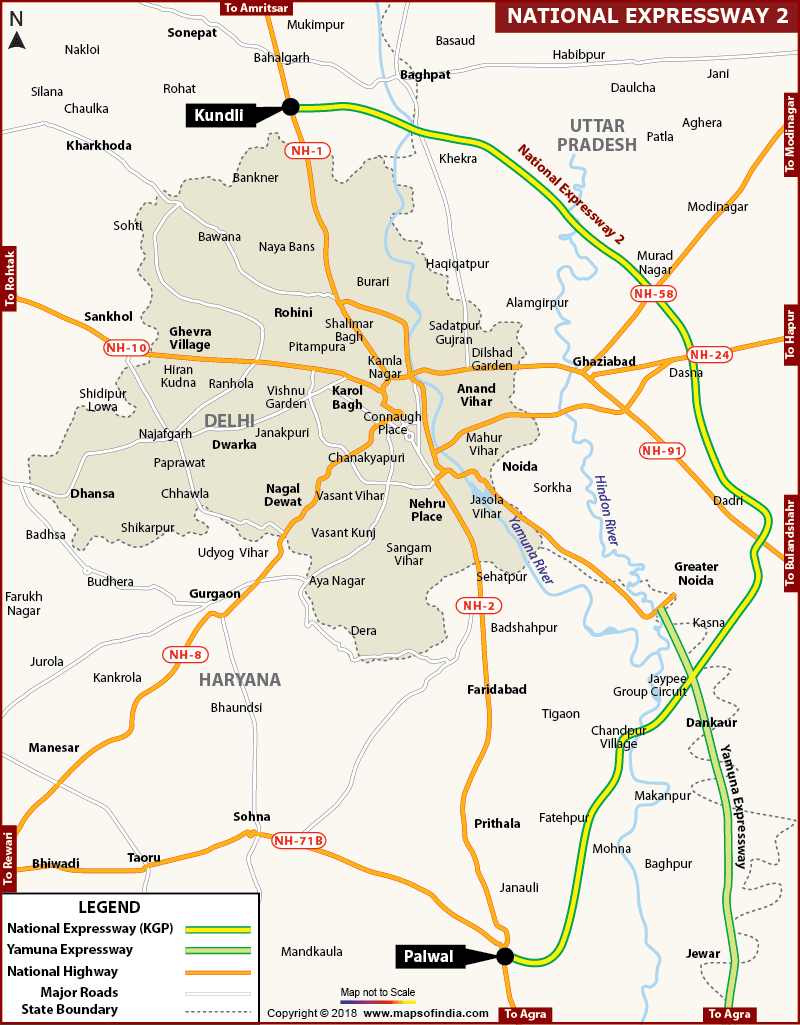Eastern Peripheral Expressway (NH-2)
The Eastern Peripheral Expressway was inaugurated by Prime Minister Narendra Modi on May 27, 2018 in view of bringing down the pollution levels in the National Capital Region. It is the first smart and green 6-lane highway of India. The expressway, also known as KGP (Kundli-Ghaziabad-Palwal) expressway, is specifically designed to connect Kundli and Palwal in Haryana via Ghaziabad to reduce the congestion on the roads of the NCR region caused by the vehicles going towards Haryana and Uttar Pradesh.
About Eastern Peripheral Expressway
The access-controlled expressway has been developed at a cost of around Rs 11,000 crore with multiple entries and exit points. The construction of the expressway was completed in 500 days as against the target of 910 days. The 135-km Eastern Peripheral Expressway is a part of the enormous Peripheral Expressway Project that consists of two highways-Eastern Peripheral Expressway and Western Peripheral Expressway. These 270-km long expressways will be surrounding Delhi like a ring road.
The route would by-pass Delhi on the eastern side and go through Haryana and Uttar Pradesh crossing the districts of Sonipat, Faridabad, Baghpat, Ghaziabad, and Gautam Budh Nagar. This long six-lane Eastern Expressway corridor will be connecting NH-1 at Kundli and NH-2 at Palwal. En route it will be crossing the Yamuna River and three other national highways. It will cross NH-58 at Murad Nagar, NH-24 at Dasna, and NH-91 at Beelakbarpur.
Benefits of Eastern Peripheral Expressway
- The expressway will help in reducing the traffic on the Delhi inner roads by offering a direct connectivity to the NCR region.
- It will help in diverting more than 2 lakh vehicles passing through the National Capital to this bypass.
- With a signal free connectivity, the expressway will link all the National Capital Region areas in the east of Delhi and reduce the traveling time to reach Faridabad, Ghaziabad, Greater Noida, Sonipat, and Palwal.
- The diversion of the traffic from NCR to this expressway will reduce the pollution levels in this region.
Facilities on this Eastern Peripheral Expressway
- Video incident detection system
- Over-speed checking system
- Pavement management systems
- Weigh-in-motion
- Warning devices
- Fibre optic network
- Electronic Toll Collection (ETC) system for faster toll collection and uninterrupted travel experience
- Concrete roads, 7 interchanges, 430 bridges, RoBs, flyovers, and underpasses
- Wayside amenities for EPE users such as washrooms, motels, petrol pumps, shops, rest areas, restaurants, repair services, etc.
Why is Eastern Peripheral Expressway Eco-Friendly?
Eastern Peripheral Expressway is an eco-friendly expressway because:-
- It helps in reducing the pollution levels in the National Capital Region.
- It uses 100% solar power for lighting.
- It has the facility of rainwater harvesting system.
- It has vertical gardens facilitated with the solar power system and drip irrigation.
- It boasts of a cycle track of 2.5 meters.
Last Updated on : February 14, 2019
|
|
